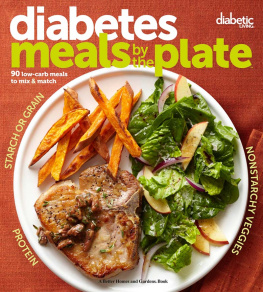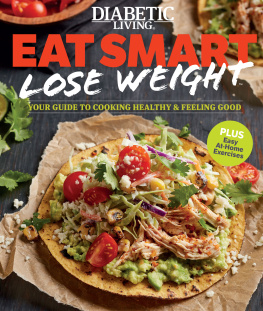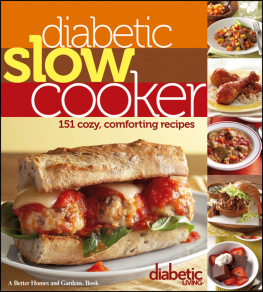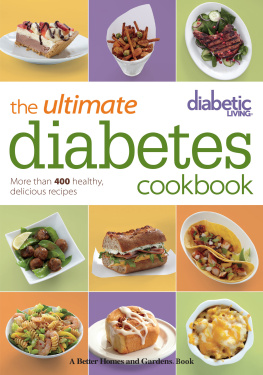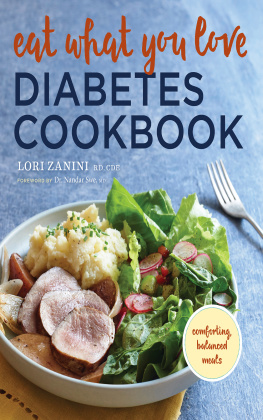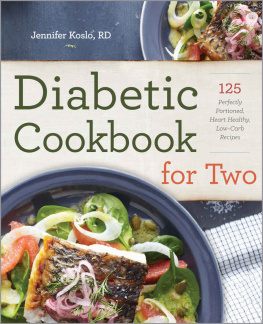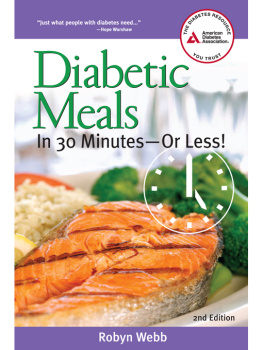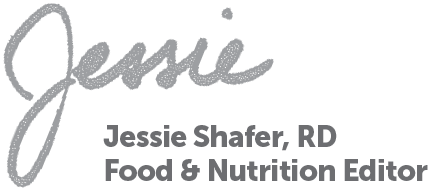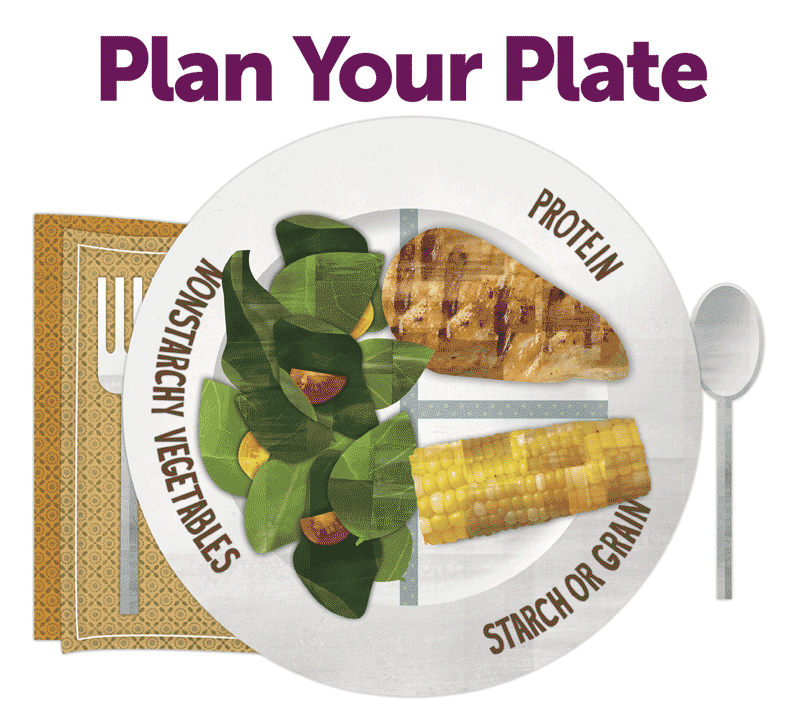Copyright 2014 by Meredith Corporation, Des Moines, IA.
For information about permission to reproduce selections from this book, write to Permissions, Houghton Mifflin Harcourt Publishing Company, 215 Park Avenue South, New York, New York 10003.
Diabetes meals by the plate : 90 low-carb meals to mix & match.
Includes index.
1.Diabetes Diet therapy Recipes. 2.Low-calorie diet Recipes
Meredith Corporation
Diabetic Living Diabetes Meals by the Plate
Food and Nutrition Editor: Jessie Shafer, RD
Art Director: Michelle Bilyeu
Contributing Project Manager: Shelli McConnell, Purple Pear Publishing, Inc.
Cover Photographer: Blaine Moats
Cover Food Stylist: Jennifer Peterson
Houghton Mifflin Harcourt
Publisher: Natalie Chapman
Editorial Director: Cindy Kitchel
Executive Editor: Anne Ficklen
Senior Editor: Adam Kowit
Editorial Associate: Molly Aronica
Managing Editor: Marina Padakis Lowry
Production Editor: Jacqueline Beach
Design and Layout: Kathryn Finney
Illustration: Patti Smith-Lawrence
Production Director: Tom Hyland
Digital Managing Editor: Rebecca Springer
v2.0716
Fill your plate & enjoy!
Theres an easy trick to healthful eating that can simplify your lifeno more counting every gram of carbohydrate, no more measuring tools, and no more guesswork about meals that are both satisfying and nutritious.
The trick is all in how you fill your plate. Visually divide your plate in half and fill one of those halves with nonstarchy vegetables. Divide the remaining half of the plate in two and fill one quarter with a protein. Fill the last quarter with a serving of grains or other starchy food. Thats it!
This simple formula is genius because the portions are built right in. Whats more, there are countless ways to mix and match your healthful mealscheck out . When you get a handle on the types of foods that fill each section of the plate, swap them to your liking. When youve mastered that, use the recipes in this book to create meals your whole family will love. Dont like one side dish? Swap it for one from another menu.
Youll notice that not all of recipes fit perfectly into the sections on the plateyoull find casseroles, pizza, and even soup where one part of the meal might contain some vegetables and some protein, or some grains and some vegetables. Thats where weve done the figuring for youand if each ingredient were to be divided out, youd still be filling your plate the right way.
We hope youll find this book is both functional and fun. Not only will it help you get dinner on the table, but it can lead to better blood sugars, weight loss, and better health. Now thats a winning formula!
Contents
Learn how to plan nutritious, balanced meals while controlling calories and carbohydrate.
Create your own plated meals by followingthis easy-to-use guide.
Chicken is an all-star option for healthful eating. Its low in calories and fat and plays well alone and in a variety of dishes.
Turkey need not be reserved for the holidays. Its versatile, low-in-fat cuts make it a healthful protein to serve year-round.
Beef boasts big flavors and provides a bundle of essential nutrients. Add variety to your weekly menus with lean beef.
When cooked to perfection, lean lamb is succulently divine. Braising, grilling, and roasting bring out its best.
Lean pork is prime when it comes to versatility. Its mild flavor is perfect for pairing with dishes of many cuisines.
From flaky fish to assorted shellfish, seafood has many health benefits. Try to incorporate at least two servings each week.
Every meal need not include meat. Eggs, tofu, and grains can step in as the lean protein. And they are ultimately healthful and filling.
Add a refreshing beverage or fruity sidedish to one of your daily meals.
When you crave something sweet, go to these indulgences with 200 calories or less.
Getting your eating on track (or fine-tuning your current meal plan) is a cinch if you use this visual guide to meals that offer the right mix of nutrients (including carbohydrate, protein, and fat) for better control of glucose and weight.
1. Start with a 9-inch plate
Portion control is easier when your plate is no more than 9 inches wide. If the actual plate size of your dinnerware is more than 9 inches, fill just inside the rim. A shallow rimmed bowl (like a pasta bowl) is also a good option, as long as it measures 9 inches wide. Along with a right-size plate, use a 1-cup glass for milk, a -cup dish for fruit or dessert, and a 1-cup bowl for cereal or soup.
2. Partition your plate
Mentally divide your plate into sections and fill it as follows:
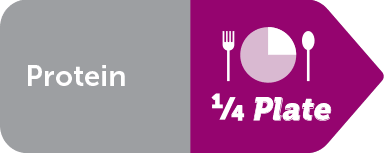 | - protein: Choose a lean meat, such as poultry, lean beef or pork, fish, tofu, eggs, cheese, or nuts.
|
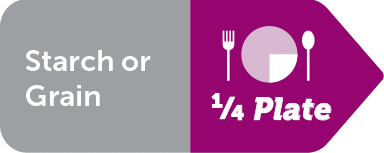 | - starch or grain: Choose a serving of bread, tortilla, pasta, rice, beans, or starchy vegetable, such as potatoes, corn, or peas. (Men may need two servings of starch.) Choose whole grains and beans to give meals a fiber boost.
|
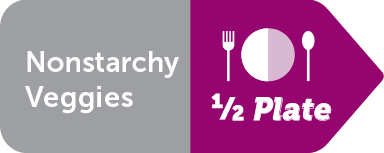 | - nonstarchy vegetables: Choose from asparagus, broccoli, carrots, green beans, cauliflower, cucumbers, peppers, salad greens, tomatoes, zucchini, and many others. For variety, pick two nonstarchy vegetables per meal.
|
3. Plate extras
For at least one meal each day, and as your calorie allowance permits, enjoy a cup of low-fat milk or light yogurt and a small piece of fresh fruit or cup cut-up fruit. When you pick low-fat options, a meal with these side items and each of the three plate components totals less than 50 grams of carbohydrate and less than 500 calories.
4. Measure the height
Dont fall into the trap of piling food too high on your plate to make up for the plates smaller size. Foods should be no more than inch high.

